warning light SUBARU OUTBACK 2005 4.G Workshop Manual
[x] Cancel search | Manufacturer: SUBARU, Model Year: 2005, Model line: OUTBACK, Model: SUBARU OUTBACK 2005 4.GPages: 627, PDF Size: 6.42 MB
Page 401 of 627
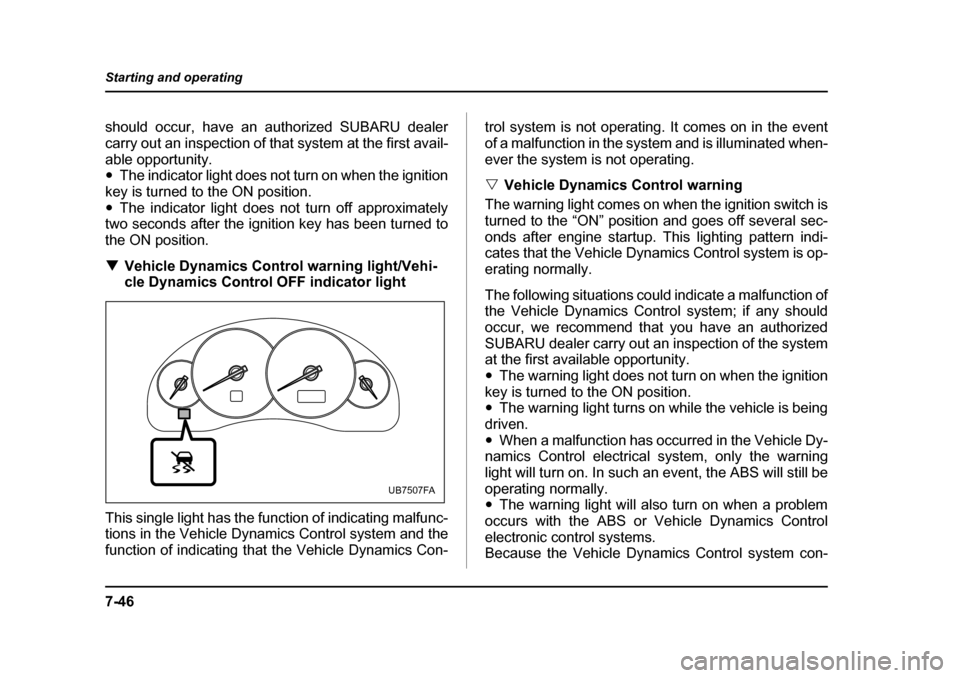
7-46
Starting and operating
should occur, have an authorized SUBARU dealer
carry out an inspection of that system at the first avail-
able opportunity. "
The indicator light does not turn on when the ignition
key is turned to the ON position. " The indicator light does not turn off approximately
two seconds after the ignition key has been turned to
the ON position. ! Vehicle Dynamics Control warning light/Vehi-
cle Dynamics Control OFF indicator light
This single light has the function of indicating malfunc-
tions in the Vehicle Dynamics Control system and the
function of indicating that the Vehicle Dynamics Con- trol system is not operating. It comes on in the event
of a malfunction in the system and is illuminated when-
ever the system is not operating. "
Vehicle Dynamics Control warning
The warning light comes on when the ignition switch is
turned to the “ON” position and goes off several sec-
onds after engine startup. This lighting pattern indi-
cates that the Vehicle Dynamics Control system is op-
erating normally.
The following situations could indicate a malfunction of
the Vehicle Dynamics Control system; if any should
occur, we recommend that you have an authorized
SUBARU dealer carry out an inspection of the system
at the first available opportunity. " The warning light does not turn on when the ignition
key is turned to the ON position. " The warning light turns on while the vehicle is being
driven. " When a malfunction has occurred in the Vehicle Dy-
namics Control electrical system, only the warninglight will turn on. In such an event, the ABS will still be
operating normally. " The warning light will also turn on when a problem
occurs with the ABS or Vehicle Dynamics Control
electronic control systems.
Because the Vehicle Dynamics Control system con-
UB7507FA
Page 402 of 627
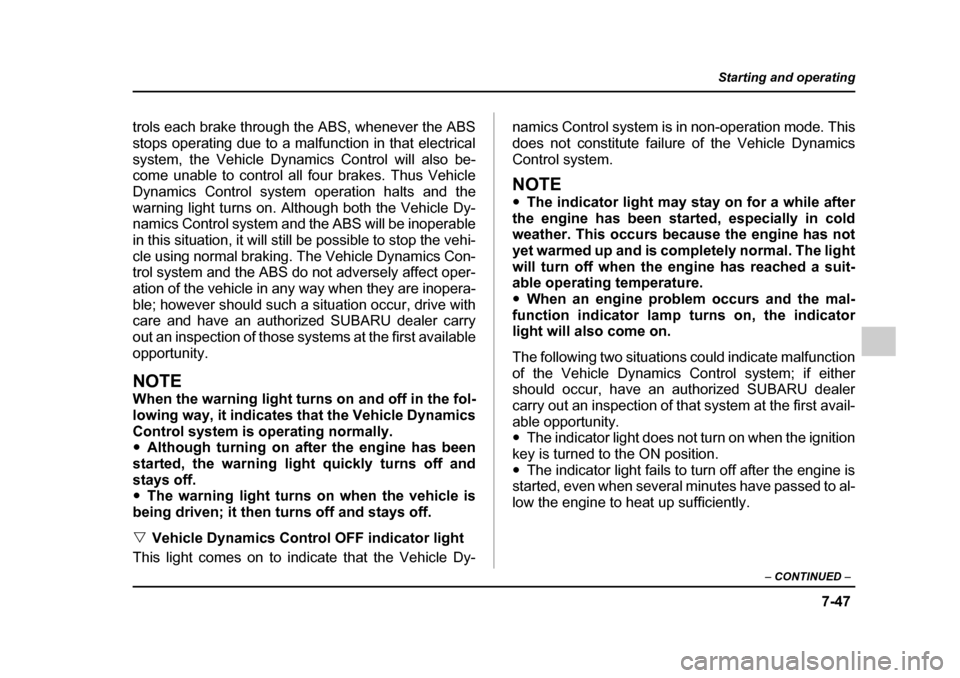
7-47
Starting and operating
– CONTINUED –
trols each brake through the ABS, whenever the ABS
stops operating due to a malfunction in that electrical
system, the Vehicle Dynamics Control will also be-
come unable to control all four brakes. Thus Vehicle
Dynamics Control system operation halts and the
warning light turns on. Although both the Vehicle Dy-
namics Control system and the ABS will be inoperable
in this situation, it will still be possible to stop the vehi-
cle using normal braking. The Vehicle Dynamics Con-
trol system and the ABS do not adversely affect oper-
ation of the vehicle in any way when they are inopera-
ble; however should such a situation occur, drive with
care and have an authorized SUBARU dealer carry
out an inspection of those systems at the first available
opportunity.
NOTE
When the warning light turns on and off in the fol-
lowing way, it indicates that the Vehicle Dynamics
Control system is operating normally. "Although turning on after the engine has been
started, the warning light quickly turns off and
stays off. " The warning light turns on when the vehicle is
being driven; it then turns off and stays off. " Vehicle Dynamics Control OFF indicator light
This light comes on to indicate that the Vehicle Dy- namics Control system is in non-operation mode. This
does not constitute failure of the Vehicle DynamicsControl system.
NOTE "
The indicator light may stay on for a while after
the engine has been started, especially in cold
weather. This occurs because the engine has not
yet warmed up and is completely normal. The light
will turn off when the engine has reached a suit-
able operating temperature. " When an engine problem occurs and the mal-
function indicator lamp turns on, the indicator
light will also come on.
The following two situations could indicate malfunction
of the Vehicle Dynamics Control system; if either
should occur, have an authorized SUBARU dealer
carry out an inspection of that system at the first avail-
able opportunity. " The indicator light does not turn on when the ignition
key is turned to the ON position. " The indicator light fails to turn off after the engine is
started, even when several minutes have passed to al-
low the engine to heat up sufficiently.
Page 404 of 627

7-49
Starting and operating
– CONTINUED –
Tire pressure monitoring system
(TPMS) (if equipped)
The tire pressure monitoring system provides the driv-
er with a warning message by sending a signal from a
sensor that is installed in each wheel when tire pres-
sure is severely low.
The tire pressure monitoring system will activate only
when the vehicle is driven at speeds above 20 mph
(32 km/h). Also, this system may not react immediate-
ly to a sudden drop in tire pressure (for example, a
blow-out caused by running over a sharp object).If the low tire pressure warning light comes on
while driving, never brake suddenly and keep
driving straight ahead while gradually reducing
speed. Then slowly pull off the road to a safe
place. Otherwise an accident involving serious
vehicle damage and serious personal injury
could occur.
Check the pressure for all four tires and adjust
the pressure to the COLD tire pressure shown
on the tire placard on the door pillar on the driv-
er’s side.
Even when the vehicle is driven a very short
distance, the tires get warm and their pressures
increase accordingly. Be sure to let the tires
cool thoroughly before adjusting their pres-
sures to the standard values shown on the tire
placard. (Refer to the “Tires and wheels” sec-
tion in chapter 11.) The tire pressure monitoring
system does not function when the vehicle is
stationary. After adjusting the tire pressures,
increase the vehicle speed to at least 20 mph
(32 km/h) to start the TPMS re-checking of the
tire inflation pressures. If the tire pressures are
now above the severe low pressure threshold,
the low tire pressure warning light should go
UB7507RA
Page 405 of 627

7-50
Starting and operating
off a few minutes later.
If this light still comes on while driving after ad-
justing the tire pressure, a tire may have signif-
icant damage and a fast leak that causes the
tire to lose air rapidly. If you have a flat tire, re-
place it with a spare tire as soon as possible.
When a spare tire is mounted or a wheel rim is
replaced without the original pressure sensor/
transmitter being transferred, the low tire pres-
sure warning light will flash. This indicates the
TPMS is unable to monitor all four road wheels.
Contact your SUBARU dealer as soon as possi-
ble for tire and sensor replacement and/or sys- tem resetting.
Do not inject any tire liquid or aerosol tire seal- ant into the tires, as this may cause a malfunc-
tion of the tire pressure sensors. If the light
flashes, promptly contact a SUBARU dealer to
have the system inspected.
Do not place metal film or any metal parts under
the driver’s seat. This may cause poor recep-
tion of the signals from the tire pressure sen-
sors, which are located there, and the tire pres-
sure monitoring system will not function prop-
erly.
NOTE
This device complies with Part 15 of the FCC
Rules and with RSS-210 of Industry Canada. Oper-ation is subject to the following two conditions: (1)
This device may not cause harmful interference,
and (2) this device must accept any interference
received, including interference that may cause
undesired operation.
Changes or modifications not expressly approved
by the party responsible for compliance could
void the user’s authority to operate the equipment.
Page 406 of 627
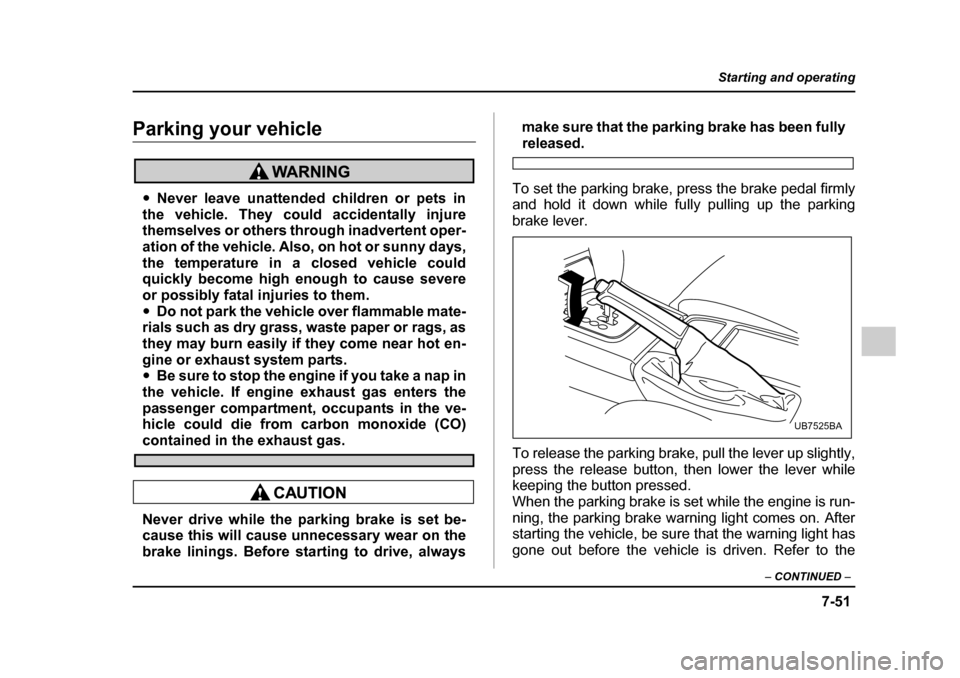
7-51
Starting and operating
– CONTINUED –
Parking your vehicle
"Never leave unattended children or pets in
the vehicle. They could accidentally injure
themselves or others through inadvertent oper-
ation of the vehicle. Also, on hot or sunny days,
the temperature in a closed vehicle could
quickly become high enough to cause severe
or possibly fatal injuries to them. " Do not park the vehicle over flammable mate-
rials such as dry grass, waste paper or rags, as
they may burn easily if they come near hot en-
gine or exhaust system parts." Be sure to stop the engine if you take a nap in
the vehicle. If engine exhaust gas enters the
passenger compartment, occupants in the ve-
hicle could die from carbon monoxide (CO)
contained in the exhaust gas.
Never drive while the parking brake is set be-
cause this will cause unnecessary wear on the
brake linings. Before starting to drive, always make sure that the parking brake has been fully
released.
To set the parking brake, press the brake pedal firmly
and hold it down while fully pulling up the parking
brake lever.
To release the parking brake, pull the lever up slightly,
press the release button, then lower the lever while
keeping the button pressed.
When the parking brake is set while the engine is run-
ning, the parking brake warning light comes on. After
starting the vehicle, be sure that the warning light has
gone out before the vehicle is driven. Refer to the
UB7525BA
Page 407 of 627

7-52
Starting and operating
“Warning and indicator lights” section (chapter 3).
When parking your vehicle, always set the parking
brake firmly and put the shift lever in the “1” (1st) for an
upgrade or “R” (Reverse) for a downgrade for manual
transmission vehicles, or in the “P” (Park) position for
automatic transmission vehicles. Always set the park-
ing brake firmly when parking your vehicle. Never rely
on the transmission alone to hold the vehicle.
When parking on a hill, always turn the steering wheel.
When the vehicle is headed up the hill, the front
wheels should be turned away from the curb.
When facing downhill, the front wheels should be
turned into the curb.
UB7510AA
UB7511AA
Page 454 of 627
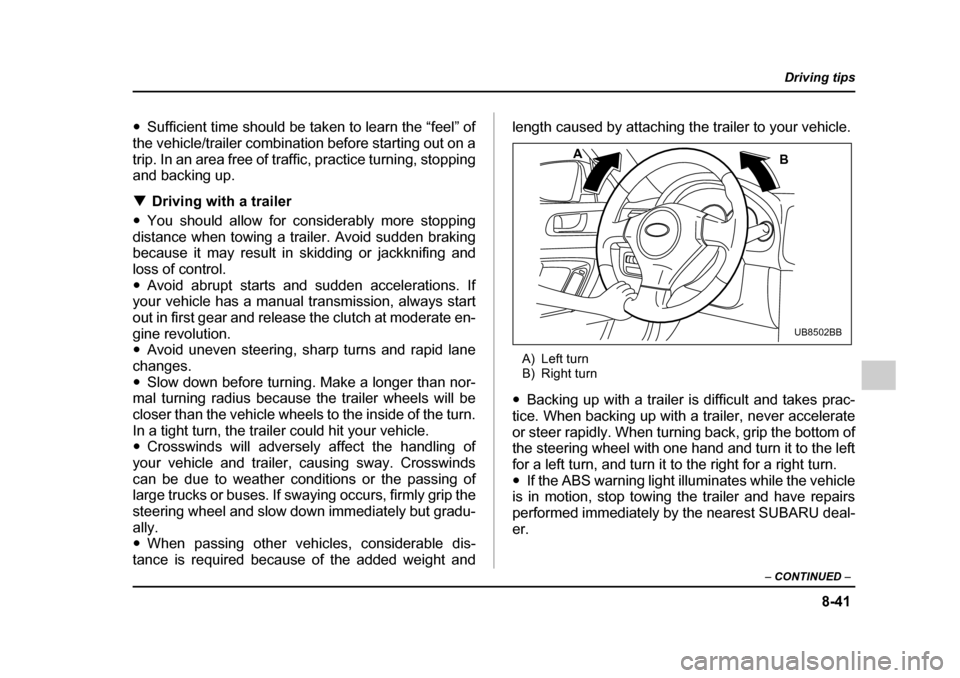
8-41
Driving tips
– CONTINUED –
"Sufficient time should be taken to learn the “feel” of
the vehicle/trailer combination before starting out on a
trip. In an area free of traffic, practice turning, stopping
and backing up. ! Driving with a trailer
" You should allow for considerably more stopping
distance when towing a trailer. Avoid sudden braking because it may result in skidding or jackknifing and
loss of control." Avoid abrupt starts and sudden accelerations. If
your vehicle has a manual transmission, always start
out in first gear and release the clutch at moderate en-
gine revolution. " Avoid uneven steering, sharp turns and rapid lane
changes. " Slow down before turning. Make a longer than nor-
mal turning radius because the trailer wheels will be
closer than the vehicle wheels to the inside of the turn.
In a tight turn, the trailer could hit your vehicle. " Crosswinds will adversely affect the handling of
your vehicle and trailer, causing sway. Crosswinds
can be due to weather conditions or the passing of large trucks or buses. If swaying occurs, firmly grip the
steering wheel and slow down immediately but gradu-
ally. " When passing other vehicles, considerable dis-
tance is required because of the added weight and length caused by attaching the trailer to your vehicle.
A) Left turn
B) Right turn
" Backing up with a trailer is difficult and takes prac-
tice. When backing up with a trailer, never accelerate
or steer rapidly. When turning back, grip the bottom of
the steering wheel with one hand and turn it to the left
for a left turn, and turn it to the right for a right turn. " If the ABS warning light illuminates while the vehicle
is in motion, stop towing the trailer and have repairs
performed immediately by the nearest SUBARU deal- er.
A B
UB8502BB
Page 455 of 627
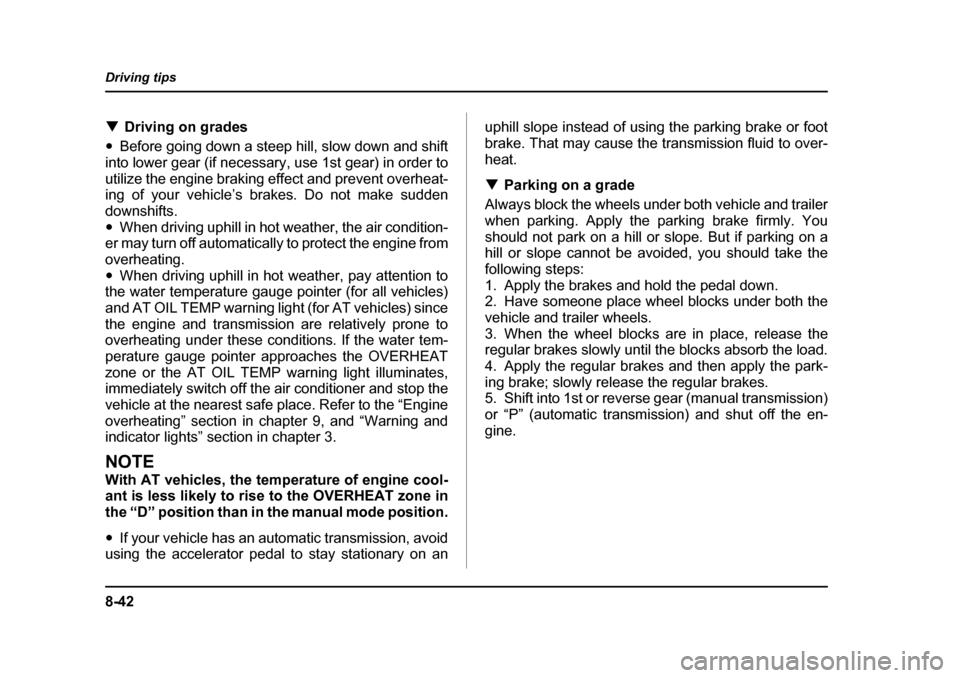
8-42
Driving tips
!
Driving on grades
" Before going down a steep hill, slow down and shift
into lower gear (if necessary, use 1st gear) in order to
utilize the engine braking effect and prevent overheat-
ing of your vehicle’s brakes. Do not make sudden
downshifts." When driving uphill in hot weather, the air condition-
er may turn off automatically to protect the engine from
overheating." When driving uphill in hot weather, pay attention to
the water temperature gauge pointer (for all vehicles)
and AT OIL TEMP warning light (for AT vehicles) since
the engine and transmission are relatively prone to
overheating under these conditions. If the water tem-
perature gauge pointer approaches the OVERHEAT
zone or the AT OIL TEMP warning light illuminates,
immediately switch off the air conditioner and stop the
vehicle at the nearest safe place. Refer to the “Engine
overheating” section in chapter 9, and “Warning and
indicator lights” section in chapter 3.
NOTE
With AT vehicles, the temperature of engine cool-
ant is less likely to rise to the OVERHEAT zone in
the “D” position than in the manual mode position. " If your vehicle has an automatic transmission, avoid
using the accelerator pedal to stay stationary on an uphill slope instead of using the parking brake or foot
brake. That may cause the transmission fluid to over-
heat. !
Parking on a grade
Always block the wheels under both vehicle and trailer
when parking. Apply the parking brake firmly. You
should not park on a hill or slope. But if parking on a
hill or slope cannot be avoided, you should take the
following steps:
1. Apply the brakes and hold the pedal down.
2. Have someone place wheel blocks under both the
vehicle and trailer wheels.
3. When the wheel blocks are in place, release the
regular brakes slowly until the blocks absorb the load.
4. Apply the regular brakes and then apply the park-
ing brake; slowly release the regular brakes.
5. Shift into 1st or reverse gear (manual transmission)
or “P” (automatic transmission) and shut off the en-
gine.
Page 458 of 627

9-3
In case of emergency
– CONTINUED –
Temporary spare tire
"Never tow a trailer when the temporary spare
tire is used. The temporary spare tire is not de-
signed to sustain the towing load. Use of the
temporary spare tire when towing can result in
failure of the spare tire and/or less stability of
the vehicle and may lead to an accident. " When a spare tire is mounted or a wheel rim
is replaced without the original pressure sen-
sor/transmitter being transferred, the low tire
pressure warning light will flash. This indicates
the tire pressure monitoring system (TPMS) is
unable to monitor all four road wheels. Contact
your SUBARU dealer as soon as possible for
tire and sensor replacement and/or system re-
setting.
Never use any temporary spare tire other than
the original. Using other sizes may result in se-
vere mechanical damage to the drive train of
your vehicle.
The temporary spare tire is smaller and lighter than a
conventional tire and is designed for emergency use
only. Remove the temporary spare tire and re-install
the conventional tire as soon as possible because the
spare tire is designed only for temporary use.
Check the inflation pressure of the temporary spare
tire periodically to keep the tire ready for use. The cor-
rect pressure is 60 psi (420 kPa, 4.2 kgf/cm 2
).
When using the temporary spare tire, note the follow-
ing: " Do not exceed 50 mph (80 km/h).
" Do not put a tire chain on the temporary spare tire.
Because of the smaller tire size, a tire chain will not fit
properly. " Do not use two or more temporary spare tires at the
same time. " Do not drive over obstacles. This tire has a smaller
diameter, so road clearance is reduced.
Page 459 of 627
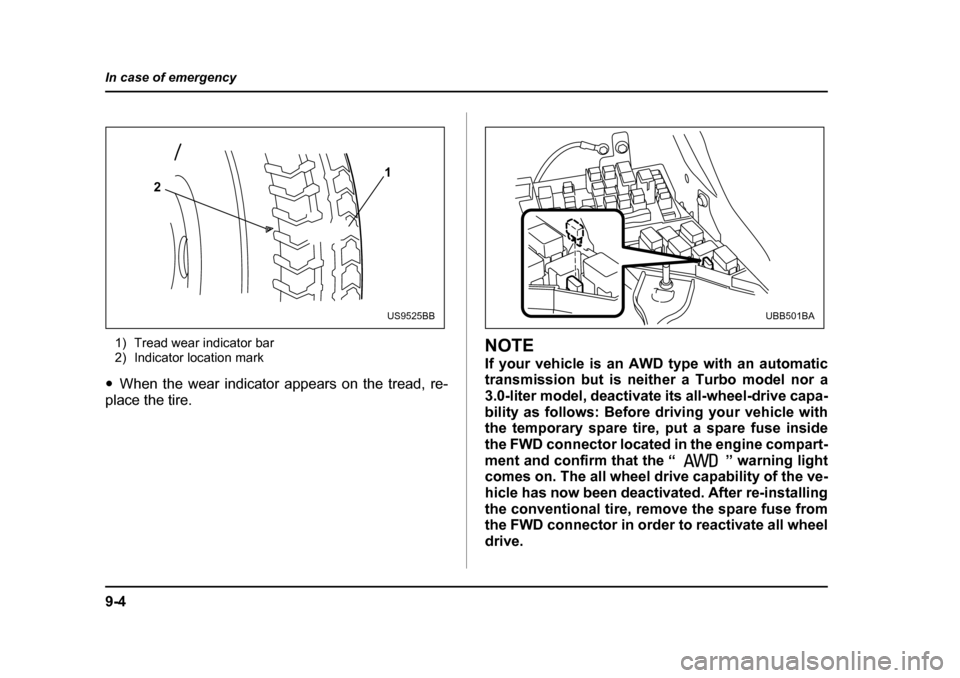
9-4
In case of emergency
1) Tread wear indicator bar
2) Indicator location mark
" When the wear indicator appears on the tread, re-
place the tire.NOTE
If your vehicle is an AWD type with an automatic
transmission but is neither a Turbo model nor a
3.0-liter model, deactivate its all-wheel-drive capa-
bility as follows: Before driving your vehicle with
the temporary spare tire, put a spare fuse inside
the FWD connector located in the engine compart-
ment and confirm that the “ ” warning light
comes on. The all wheel drive capability of the ve-
hicle has now been deactivated. After re-installing
the conventional tire, remove the spare fuse from
the FWD connector in order to reactivate all wheel
drive.
1
2
US9525BBUBB501BA